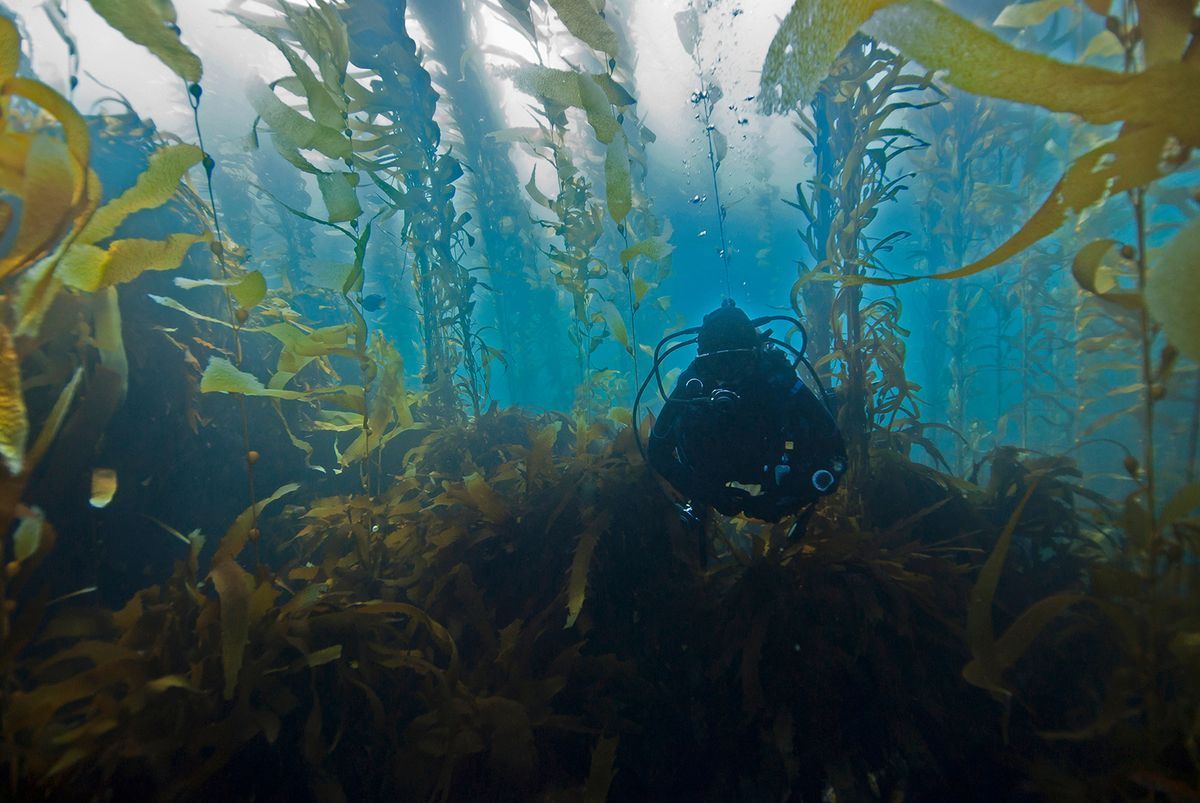The key role of the Amazon rainforest both in sequestering carbon and supporting a rich diversity of ecosystems is well known. But equally crucial to the wellbeing of the planet—if less high profile—are the giant kelp forests that lie beneath the world’s oceans and line one quarter of all coastlines. Like their land-based counterparts, these underwater forests of brown algae are also vanishing at an alarming rate. Southern Australia and Northern California have lost 95% of their kelp forests and rapid declines are occurring on every continent due to a lethal combination of rising sea temperatures, pollution and aggressive fishing techniques.
“Kelp is extraordinary: it's the marine forest, the aquatic Amazon of biodiversity and it’s also the fastest-growing organism on the planet,” says the artist Petroc Sesti. “Kelp de-acidifies the water, it oxygenates it and literally pulls carbon out of the water. And it doesn't take anything from the planet because it doesn’t actually have a root.”
In 2018, together with the conservationist and philanthropist Ruth Ganesh, Sesti co-founded Platform Earth, an environmental charity which aims to unite artists with scientists and to fund marine carbon capture projects from the sale of artworks. Now, in great part thanks to Platform Earth, some of these oceanic kelp forests—specifically those around the south coast of the UK which had shrunk to 4% of their former size—are staging a comeback.
In addition to giving substantial support to the Sussex Kelp Restoration Project, including two research programmes into the regrowth of kelp and tracking the amount of carbon captured, Platform Earth also played a key role in the successful 2021 campaign to ban damaging trawl fishing off the West Sussex coast, making it the largest marine protected area in the UK. Last year the charity began to support ecosystem restoration and carbon sequestration in the degraded Solent waterway between England and the Isle of Wight and there are also plans afoot to extend its activities to the waters around Jersey.
“Once protected and restored, the south coast’s blue-carbon habitats alone have the capacity to counteract the UK art industry’s carbon footprint,” according to Sesti. And it’s not just the UK’s coastal waters that Platform Earth has in its sights. In 2023 the charity is embarking on a major mangrove restoration project in Honduras, covering an area of more than 2,000 hectares in the Bay of Fonseca. Sesti observes that “mangroves can sequester four times more carbon than rainforests”.
In the spirit of sustainability, the artworks donated by leading artists to fund Platform Earth’s environmental programmes are all made using specially developed recycled materials designed to minimise their carbon footprint. The charity’s Carbon Collection, first presented at Frieze London in 2021, consists of more than 50 editions and original works commissioned from Antony Gormley, Marina Abramovic, Rachel Whiteread, Cornelia Parker, Tracey Emin, Haroon Mirza and Mark Wallinger, amongst many others.
Each artwork has been made with Air-Ink, an ink developed by Graviky Labs at MIT from the exhaust fumes collected from cars, chimneys and generators in Delhi and other cities. This radical new medium is stored in pens made from recycled plastic that each contain 45 minutes' worth of pollution from a single vehicle. They are shipped to the UK by boat, not air. In addition, all the paper used in Platform Earth’s Carbon Collection is recycled and the frames are made with FSC-approved wood.
As the works are sold to finance Platform Earth’s "blue carbon" marine projects, new ones are constantly joining the Carbon Collection. Last year the artist and designer Es Devlin created I Saw the World End, a giant three-metre-long Air-Ink work on paper which was shown at the entrance of Frieze London and accompanied by an edition of smaller related prints. New editions for 2023 include contributions from Brian Eno, Mark Wallinger and Rachel Whiteread, as well as an original work by Jonathan Yeo depicting a map of the Netherlands partly submerged by predicted rises in sea levels.
Research is ongoing into other sustainable materials for artists, most notably CarbonXinc, a new cement-like substance that can be used for sculptures both marine and terrestrial. This miracle material apparently sucks carbon dioxide from the atmosphere and turns it into a solid medium. “We have to have some bold ideas,” Sesti says. In his own practice he has created a CarbonXinc underwater sculpture titled The Heart of Okeanos, which will support live corals and will form part of Miami Beach’s forthcoming ReefLine underwater sculpture park and artificial reef.
From Sussex kelp to Honduras mangroves, via the polluted streets of Delhi and the studios of some of our leading artists, Platform Earth is an enterprise with big ambitions. “By arming leading artists with carbon-negative art mediums and an environmentally considered approach to exhibitions and events, Platform Earth seeks a positive, solution-based cultural movement toward achieving net zero for the arts and industry at large,” says its co-founder.




